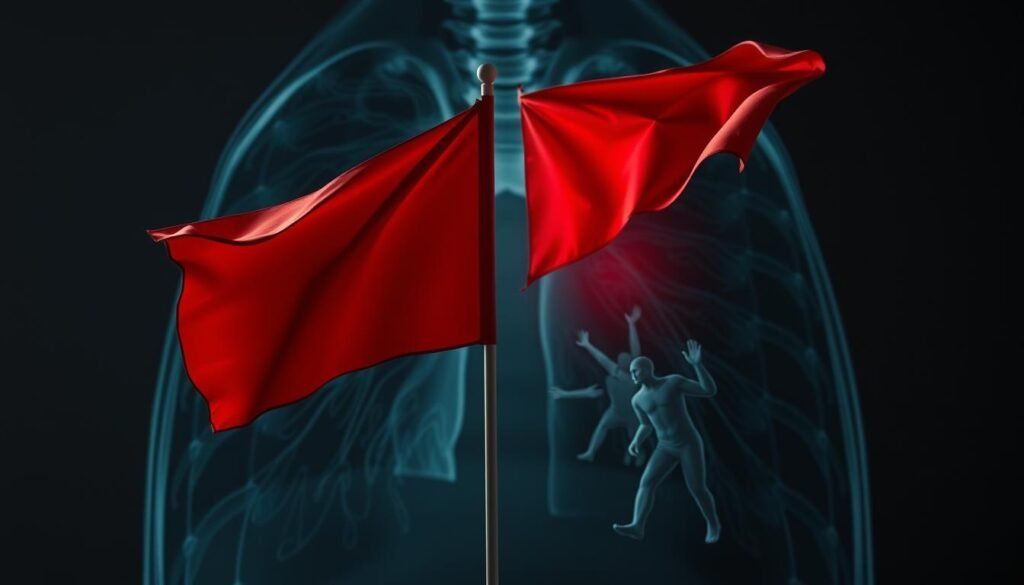About 1 in every 4 people with lung cancer report having back pain. This shows a link between lung cancer and back pain. Many think back pain is due to normal strains or injuries. Yet, if back pain comes with symptoms like chronic cough or losing weight without trying, it may warn of lung cancer.
Knowing how back pain and lung cancer are connected helps people get help sooner. This can improve the chances of getting better. We will look at how back pain ties to lung cancer and point out warning signs.
Key Takeaways
- About 25% of lung cancer patients experience back pain.
- Recognizing warning signs of lung cancer can lead to earlier diagnosis.
- Back pain may indicate tumors pressing on nerves or spinal structures.
- Awareness of symptoms can guide timely medical attention.
- Two types of cancer-related back pain include spinal metastasis and soft tissue metastasis.
- Seeking assistance can be crucial in managing back pain effectively.
Understanding Lung Cancer and Its Symptoms
Lung cancer is the second most common cancer in the United States. It happens when cells in the lungs grow out of control. This can create tumors. Often, people don’t know they have it until it’s pretty advanced.
Signs of lung cancer include a cough that won’t go away and trouble breathing. Coughing up blood is another serious sign. Also, getting sick a lot with things like bronchitis might mean lung cancer is present. Chest pain could be a sign too, especially if a tumor is pushing on something.
About 1 in 4 people with lung cancer will have back pain. This pain often shows up with fatigue, losing weight without trying, and a constant cough. Knowing these symptoms is important. It can help tell lung cancer apart from other illnesses. If you see these warning signs, talking to a doctor can make a big difference.
Learning early signs of lung cancer is crucial. For more details, looking at resources like lung cancer signs can help. Working with doctors can lead to better treatments and outcomes.
The Role of Back Pain in Lung Cancer Diagnosis
Back pain is a key sign in diagnosing lung cancer. Many people feel this pain when they’re sick. Though it’s not always the first sign, it leads to more checks if there’s also breathing trouble. Shoulder and neck pain often go with back pain in lung cancer, showing the need for a full check-up.
Some may have back pain as their only sign. This is rare but shows lung cancer can be complex. Other usual symptoms are a long-lasting cough, losing weight, feeling very tired, and wheezing. Knowing these links helps find and treat lung cancer early, which is vital for getting better.
Lung cancer can spread to the spine, causing back pain. This happens when tumors press on nerves. Then, doctors use X-rays, CT scans, and MRI scans to see how back pain and cancer are linked. About 30% to 40% of people with a certain lung cancer have it spread to their bones, showing a clear connection between back pain and the advance of lung cancer.
Lung Cancer Symptoms Back Pain: What to Watch For
If you feel back pain and wonder about lung cancer symptoms back pain, pay attention. This kind of pain might mean you have a health problem like lung cancer. You might also have a cough, feel out of breath, or lose weight suddenly.
Sometimes, back pain is the only sign of lung cancer. This makes finding the disease early hard. But if your back pain gets worse when you laugh or breathe, it could be serious. You should watch how your pain feels and changes over time.
Knowing about pain linked to cancer can help catch it early. A lot of people with lung cancer have pain in their back, shoulders, or neck. They might also have the usual signs of lung problems. Tests like X-rays and MRI scans are useful to see if the back pain is because of lung cancer. Finding cancer soon can lead to better health outcomes. So, it’s vital to tell your doctor about any strange or ongoing pains.
Other signs to look out for are:
- Chronic cough
- Coughing up blood
- Chest infections
- Fatigue
- Hoarseness
- Swelling in the face or neck
Understanding lung cancer starts with knowing the risk factors, like smoking, being around secondhand smoke, and past radiation exposure. This shows why it’s key to act early. If you have unexplained back pain, talk to your doctor. It’s important to figure out what’s causing it as soon as possible.
Common Causes of Back Pain Not Related to Cancer
Back pain has many causes that aren’t cancer. These include muscle strains, arthritis, and degenerative disc disease. Lifestyle choices can make these worse. For example, bad posture and injuries can increase back pain. Also, conditions like osteoporosis can make your back hurt.
Being overweight is also a big problem for back pain. People who are heavier might have trouble breathing. This can feel like back pain. Plus, scoliosis, which often starts in teens, can cause back pain too. It does this by putting extra pressure on the lungs.
Most back pain comes from mechanical issues. In fact, about 90% of back pain is because of this. Problems like kyphosis make your spine curve forward. This can cause swelling and make it hard to balance. Also, a pulmonary embolism happens when a blood clot gets into a lung artery. It’s very serious and can make your upper back hurt and make it hard to breathe.
Infections like pneumonia can make your chest and back hurt, especially when you cough or breathe deeply. Intercostal neuralgia can make this worse. It causes pain in your chest and ribs. You might also feel tingling and numbness.

Knowing these causes can help you figure out when to get help. This is especially true for serious conditions. Understanding them is the first step in getting the right treatment. And that can help ease your pain.
| Condition | Symptoms | Potential Treatments |
|---|---|---|
| Muscle Strain | Localized pain, stiffness | Rest, ice, pain relievers |
| Arthritis | Joint pain, swelling | Physical therapy, medications |
| Degenerative Disc Disease | Pain that worsens with movement | Exercise, pain management |
| Scoliosis | Pain with breathing, postural issues | Bracing, physical therapy |
| Obesity | Pain during activity | Weight management, lifestyle changes |
How Lung Cancer Can Cause Back Pain
Back pain from tumors occurs in various ways when lung cancer is there. About 25% of people with lung cancer feel back pain. This often happens even before they know they have non-small cell lung cancer (NSCLC).
Mechanisms of Pain from Tumors
Lung cancer tumors can press on areas around them. This pressure might hurt nearby nerves, leading to pain that can be sharp or dull. Symptoms like a persistent cough, breathing troubles, and coughing up blood are common with NSCLC.
Doctors might use X-rays, CT scans, or MRIs to check why you have back pain related to cancer.
Spinal Metastasis: When Cancer Spreads to the Spine
Spinal metastasis is when cancer moves to the spine. It can cause a lot of pain and make it hard to move. If you have sudden back pain with NSCLC symptoms, see a doctor right away.
There are many treatments for this, from medicine and therapy to surgery. They aim to ease the pain from this condition.
Red Flags Indicating Lung Cancer Pain
Knowing the signs of back pain is key for early lung cancer detection. There are several red flags lung cancer signs in people with back pain. Spotting these early might mean better chances of beating the disease.
Persistent Pain During Rest
Persistent back pain that doesn’t go away with rest could be serious. It might stay the same no matter what you do. If you have this kind of pain, see a doctor to check for cancer.
Back Pain that Worsens at Night
Back pain that gets worse at night is worrying. It could mean a more severe problem if you also feel very tired or lose weight without trying. If lying down makes the pain worse, it’s especially vital to get it checked out.

If your back pain fits these descriptions, get checked by a doctor. They might do scans or other tests to find out what’s wrong. Always watch for changes in how your pain feels, especially with other weird symptoms. For more info on how back pain and lung cancer are linked, visit this resource.
Evaluating Back Pain: When to Seek Medical Attention
Knowing when to see a doctor for back pain is vital for your health. If back pain lasts more than six weeks, it’s time to seek help. Sometimes, despite trying treatments at home, pain gets worse. This could mean you need a professional’s advice.
If the pain comes with feeling very tired or having trouble breathing, it’s even more urgent. Such symptoms should not be ignored at all.
When checking for lung cancer signs, certain alerts should not be missed. These include coughing, chest pain, and losing weight without trying. Doctors can do tests like scans or bloodwork to find out what’s wrong. They will look closely if back pain might tie to lung cancer.
| Symptom | Action to Take |
|---|---|
| Pain lasts longer than 6 weeks | Seek medical attention |
| Worsens despite treatment | Consult a healthcare provider |
| Included fatigue or breathing difficulties | Request evaluations to evaluate lung cancer symptoms |
| Coughing up blood | Immediate medical attention required |
| Unintentional weight loss | Discuss with a doctor |
Taking action early can make a big difference. By being aware of these signs, you can protect your health better. Getting the right care and attention timely is crucial.
Cancer Symptom Management for Back Pain
For people with lung cancer, managing back pain takes many steps. It mixes home care, lifestyle changes, and medical treatments to boost comfort and health. This range of strategies can help patients feel much better.
Home Remedies and Lifestyle Modifications
There are a few home remedies and changes that can help with cancer symptom management for back pain. These steps include:
- Using heat and ice therapies to lessen pain.
- Improving posture to reduce back strain.
- Exercising regularly within personal limits.
- Eating well to support your body’s health.
Making these lifestyle for back pain changes can make a big difference in everyday life.
Medical Treatment Options
For those facing severe back pain, there are many back pain treatment options to consider. Medical choices may be:
| Treatment Type | Description |
|---|---|
| NSAIDs | These are over-the-counter drugs that lessen pain and swelling. |
| Prescription Pain Relievers | Doctors can prescribe these stronger meds for tough pain. |
| Cancer Therapies | These include radiation or steroids to tackle pain from tumors. |
| Surgery | This might be needed for intense back pain from metastasis. |
For more insights, check out information on managing lung cancer symptoms. It’s vital to know all options, to choose wisely and find relief.

Palliative Care: Supporting Those with Lung Cancer
Palliative care for lung cancer helps improve life quality for those with the illness. This approach eases symptoms and supports emotional health. It offers comfort throughout a patient’s journey, not just treatment for cancer.
Patients benefit from palliative care at any stage of lung cancer. Teams of healthcare professionals create customized support plans. They tackle pain, anxiety, and fatigue to ease a patient’s distress.
It’s important to talk about palliative care right after a lung cancer diagnosis. This allows patients to find treatments that lessen symptoms like breathlessness and pain. Options include pain medication, nutritional support, and home oxygen therapy for lung fluid.
Palliative care is useful at any illness stage and for various needs. People can seek help for treatment side effects or emotional struggles. Medicare and Medicaid often help cover the cost, making it more accessible.
This care combines medical and emotional support for patients and families. The team effort makes a big difference for those facing lung cancer. It greatly improves the experience during such a tough time.
Conclusion
The link between lung cancer awareness and back pain symptoms is key for early finding and treatment. If someone has ongoing back pain along with other serious signs, they should be careful. Knowing these signs early can mean getting help sooner, which can make a big difference in surviving.
Last year alone, more than 196,000 people were found to have lung cancer. Not just smokers get lung cancer; it also happens in people who’ve never smoked. It’s important to know about different lung cancers and their spread to the spine. This explains why we shouldn’t ignore symptoms like back pain.
To sum up, acting early on symptoms and understanding lung cancer’s link to back pain can improve lives. Getting help quickly is critical. Being informed helps people make the right health choices and get the advice they need fast.